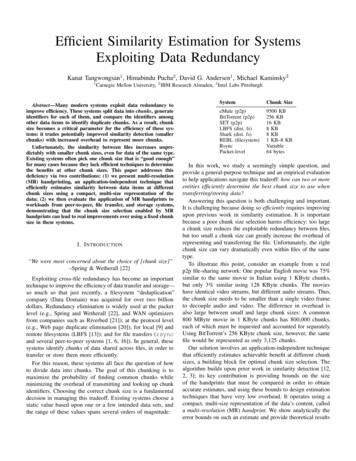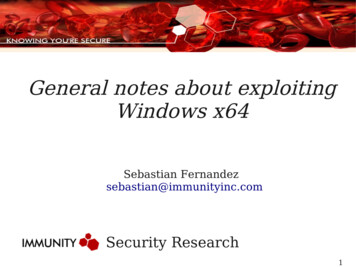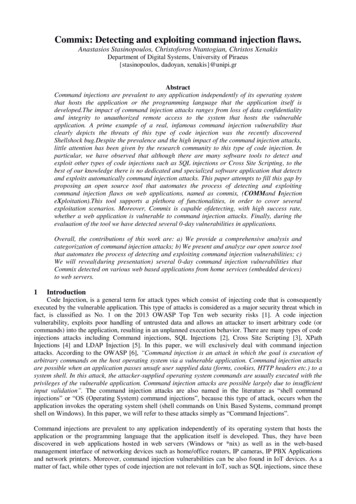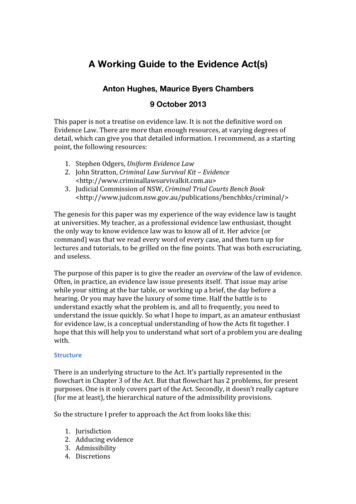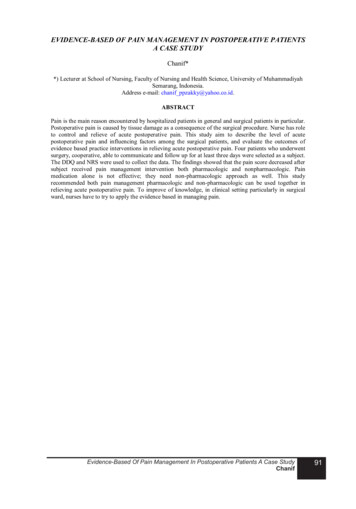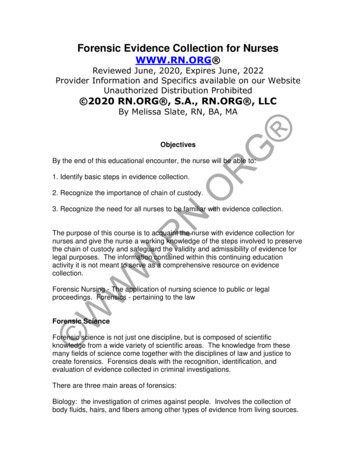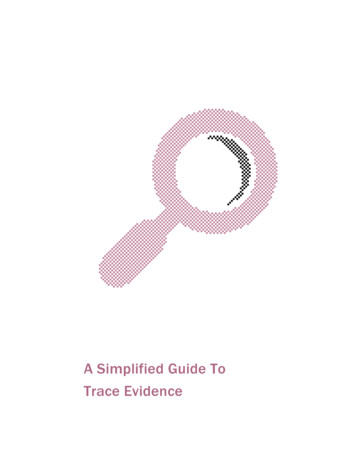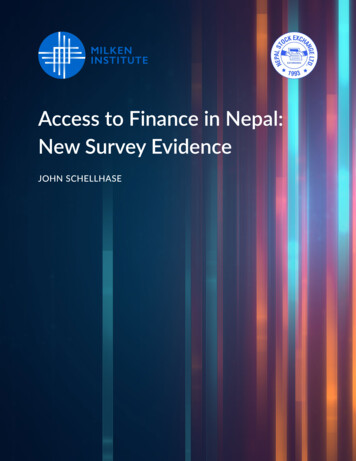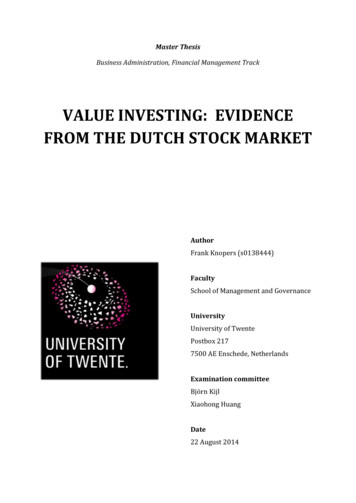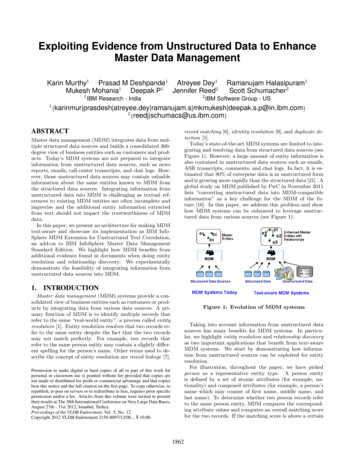
Transcription
Exploiting Evidence from Unstructured Data to EnhanceMaster Data ManagementKarin Murthy1 Prasad M Deshpande1 Atreyee Dey1Mukesh Mohania1 Deepak P1 Jennifer Reed2112IBM Research - IndiaRamanujam Halasipuram1Scott Schumacher2IBM Software Group - US{karinmur prasdesh atreyee.dey ramanujam.s mkmukesh deepak.s.p@in.ibm.com}2{reedj schumacs@us.ibm.com}ABSTRACTrecord matching [6], identity resolution [9], and duplicate detection [5].Today’s state-of-the-art MDM systems are limited to integrating and resolving data from structured data sources (seeFigure 1). However, a large amount of entity information isalso contained in unstructured data sources such as emails,ASR transcripts, comments, and chat logs. In fact, it is estimated that 80% of enterprise data is in unstructured formand is growing more rapidly than the structured data [21]. Aglobal study on MDM published by PwC in November 2011lists “converting unstructured data into MDM-compatibleinformation” as a key challenge for the MDM of the future [16]. In this paper, we address this problem and showhow MDM systems can be enhanced to leverage unstructured data from various sources (see Figure 1).Master data management (MDM) integrates data from multiple structured data sources and builds a consolidated 360degree view of business entities such as customers and products. Today’s MDM systems are not prepared to integrateinformation from unstructured data sources, such as newsreports, emails, call-center transcripts, and chat logs. However, those unstructured data sources may contain valuableinformation about the same entities known to MDM fromthe structured data sources. Integrating information fromunstructured data into MDM is challenging as textual references to existing MDM entities are often incomplete andimprecise and the additional entity information extractedfrom text should not impact the trustworthiness of MDMdata.In this paper, we present an architecture for making MDMtext-aware and showcase its implementation as IBM InfoSphere MDM Extension for Unstructured Text Correlation,an add-on to IBM InfoSphere Master Data ManagementStandard Edition. We highlight how MDM benefits fromadditional evidence found in documents when doing entityresolution and relationship discovery. We experimentallydemonstrate the feasibility of integrating information fromunstructured data sources into MDM.1. INTRODUCTIONMaster data management (MDM) systems provide a consolidated view of business entities such as customers or products by integrating data from various data sources. A primary function of MDM is to identify multiple records thatrefer to the same “real-world entity”, a process called entityresolution [1]. Entity resolution resolves that two records refer to the same entity despite the fact that the two recordsmay not match perfectly. For example, two records thatrefer to the same person entity may contain a slightly different spelling for the person’s name. Other terms used to describe the concept of entity resolution are record linkage [7],Figure 1: Evolution of MDM systemsTaking into account information from unstructured datasources has many benefits for MDM systems. In particular, we highlight entity resolution and relationship discoveryas two important applications that benefit from text-awareMDM systems. We start by demonstrating how information from unstructured sources can be exploited for entityresolution.For illustration, throughout the paper, we have pickedperson as a representative entity type. A person entityis defined by a set of atomic attributes (for example, nationality) and composed attributes (for example, a person’sname which may consist of first name, middle name, andlast name). To determine whether two person records referto the same person entity, MDM compares the corresponding attribute values and computes an overall matching scorefor the two records. If the matching score is above a certainPermission to make digital or hard copies of all or part of this work forpersonal or classroom use is granted without fee provided that copies arenot made or distributed for profit or commercial advantage and that copiesbear this notice and the full citation on the first page. To copy otherwise, torepublish, to post on servers or to redistribute to lists, requires prior specificpermission and/or a fee. Articles from this volume were invited to presenttheir results at The 38th International Conference on Very Large Data Bases,August 27th - 31st 2012, Istanbul, Turkey.Proceedings of the VLDB Endowment, Vol. 5, No. 12Copyright 2012 VLDB Endowment 2150-8097/12/08. 10.00.1862
threshold, MDM automatically merges the two records intoa single entity.For various reasons two records that belong to the sameentity (that is, they actually refer to the same person) maynot match sufficiently for MDM to automatically merge them.For example, one or both records may be incomplete orsome attribute values may be incorrect. If two such recordsscore sufficiently close to the threshold for automatic merging, MDM marks the two records for manual inspection.During manual inspection, a data analyst needs to decidewhether the two records belong to the same person or not.For this task, information extracted from unstructured datamay provide the missing evidence that enables the data analyst to make a decision.Figure 2: Entities in MDMManosh Patil and Sarah Lee from IBM met in NewYork with Tom Smith from ABC to discuss XYZ. Themeeting took place on 21. Aug 2011.Manosh from IBM in India is currently on a six monthassignment to the office in New York to help Sarah andTom with planning XYZ, a joint growth-market initiativeof IBM and ABC. Tom is scheduled to spend considerable time in India later this year to oversee the executionof XYZ in India.Please contact Manosh (mpatil3@in.ibm.com) or Tom(tom.s@abc.com) for further information.Figure 4: Improved entity resolutionentities. For example, an enterprise might want to detectvarious kinds of relationships between its customers, for example, whether two customers belong to the same family orhousehold. Simple relationships can often be detected basedon a match on attribute values; examples include matchingthe last names or matching the address attribute.Other relationships may not be as obvious and depend onthe context for which the entities intersect. For example, ina public-safety scenario, the government might like to trackcertain suspicious entities and detect any relationships between them. Documents such as news reports, emails, orother confidential reports often contain information aboutmultiple entities and capture that two entities interactedwith each other or are related to on another and the relationship context. Text-aware MDM systems can extractthese types of relationships leading to richer master data. Inour example, the document shown in Figure 3 provides evidence that a relationship exists between the MDM entities1, 3, and 5. See Figure 5 for an illustration.Figure 3: Document linking the entitiesAs an illustration, consider the MDM dataset in Figure 2.It is possible that records 3 and 4 belong to the same entity,but there is not enough evidence to automatically mergethem. These records remain unlinked in the MDM system.Now consider the text document shown in Figure 3 mentioning some of the MDM entities of Figure 2 (highlightedin bold). Based on existing master data information, fournew person records can be extracted from the document andlinked to existing entities as shown at the bottom of Figure 4.(The details of this process are described in Section 4). Inthe example, the extracted record 8 is linked to the existingentity 3 whereas the extracted record 9 is linked to the existing entity 4. The information that the two records 8 and9 were extracted from the same document may be enoughadditional evidence for a user to decide that entities 3 and4 pertain to the same person and should be merged into asingle entity.The second application that benefits from text-aware MDMis relationship discovery, which is the task of identifying relationships between distinct entities. Traditionally, MDMsystems have focused on entity resolution and gathering allinformation about an entity. However, in some applications,it is also useful to identify relationships between different1863Figure 5: Improved relationship discoveryIn this paper, we describe a system that can use the abovedescribed evidence from unstructured information sourcesto enhance master data management. EUTC (Extensionfor Unstructured Text Correlation) bridges the gap betweenstructured and unstructured data and enables MDM systems to provide a real 360-degree view of each entity. To linkstructured and unstructured data, EUTC automatically extracts references to existing entities from arbitrary text. Theextracted entity references allow MDM systems to improveentity resolution and relationship discovery for existing master data.EUTC addresses three main challenges: Text is noisy by nature and entity references are often incomplete and uncertain. Thus, the system needsto be tolerant to spelling variations, allow for fuzzymatching of values, and be able to deal with incomplete references.
Multiple entities may be mentioned in the same document and may be referenced even within the samesentence. Thus, the system can not rely on techniquesthat require each entity to be mentioned within its ownunit of text such as a sentence or paragraph. Different types of entities (for example, products orpersons) are described by different attributes. Andeven the same type of entity may be described differently in different domains. For example, in a publicsafety scenario, a person’s description may include attributes such as nationality, passport number, and placeof birth; whereas a human-resource scenario may include attributes such as email address, employee ID,and salary. Thus, the system should not rely on techniques that exploit domain-dependent data semantics.Figure 6: Attributes of person memberEUTC addresses these three challenges and provides ageneric approach to extract entity-related information fromany type of document with respect to any type of MDM system domain. It leverages the probabilistic matching functionality provided by MDM systems to identify the matchingentities. A specific instance of EUTC has been implementedas IBM InfoSphere MDM Extension for Unstructured TextCorrelation, an add-on to IBM Initiate Master Data Serviceversion 9.7 and IBM InfoSphere MDM Standard Edition version 10. Wherever needed, we use this implementation forexplanation and experiments. However, EUTC as a conceptis not limited to a specific MDM system.The remainder of the paper is organized as follows. InSection 2, we describe the architecture of the system andrun through an example execution. In Section 3, we explainhow existing structured data in MDM systems is leveragedfor information extraction. Section 4 describes how EUTCexploits the matching capability provided by MDM for itsentity construction. We evaluate the system experimentallyand present the quality and performance results in Section 5.Finally, we present some related work in Section 6 and conclude the paper in Section 7.an entity is the logical link between two or more memberrecords. An entity is sometimes also called a linkage set.For example, in Figure 5, two member records are groupedinto entities 3 and 8, respectively.Attribute Matching or Scoring is the process of comparingindividual attributes using one or more appropriate comparison functions. For example, to match two person names,a phonetic comparison based on Soundex and a syntacticcomparison based on edit distance may be used. The combined output of all comparison functions for matching twoattribute values is called matching score.Record Matching or Scoring is the process of combiningthe individual attribute-level scores to arrive at the likelihood that two records belong to the same entity. MDS applies a likelihood function to determine the probability thatdifferent values of an attribute match and how much weighta given attribute should contribute to the overall score between two records. This process of comparing two memberrecords is also referred to as probabilistic matching. For details on MDS matching we refer the interested reader to theIBM white paper on data matching [8].Entity resolution is the process of merging two (or more)member records into a single entity. This happens automatically if the records’ matching score exceeds the autolink threshold or manually if the score exceeds the reviewthreshold and a user determines that the records belong tothe same entity.A relationship is a link between two distinct entities. Forexample, in Figure 5 entities 6, 7, and 8 are directly linked bythe fact that they all appear in the same document; entities1, 3, and 5 are indirectly linked by the fact that they are alllinked to entities extracted from the same document.2. SYSTEM OVERVIEWIn this section, we introduce some MDM terminology, describe the architecture of EUTC and its individual components, and walk through an example of the execution of theEUTC process.2.1MDM Terminology and ConceptsWe use IBM Initiate Master Data Service (MDS) for illustrations and for the experimental evaluation. Thus, theMDM terminology introduced here is influenced by the terminology used in the context of MDS.A member is defined as a set of attributes that represents atype of individual (for example, a person or an organization)or a type of thing (for example, a car or a machine part).For illustration, we use the member type Person, which isdefined by a set of demographic attributes. Figure 6 showsthe snapshot of a sample MDS data model for the personmember type.A member record is the set of all attribute values that asingle source system asserts to be true about a person. Forexample, each row in Figure 2 is a member record.An entity is defined as “something that exists as a particular and discrete unit”. In terms of data management,2.2EUTC Architecture and Components2.2.1 ArchitectureFigure 7 shows the basic architecture of EUTC. EUTC interacts both with structured and unstructured data sources.Structured data is provided by an MDM system. WhileEUTC works in principle with any MDM system (or forthat matter any source of structured entity data), an MDMsystem that encompasses sophisticated methods for matching, can significantly improve EUTC’s performance. (Wediscuss this aspect in Section 2.2.5.)1864
Figure 8: Definition of MDS attribute type ADDRESSFigure 7: Architecture of EUTCUnstructured data can come from many different sources.Content management systems such as EMC’s Documentum1or IBM’s FileNet P82 may invoke EUTC whenever a newdocument is uploaded to the document management system.However, unstructured text may also reside in the file system or be stored along with structured data as a CLOB in adatabase. In such cases, a separate event handler is neededto monitor the unstructured data and invoke EUTC whenever new text is available. When EUTC is first installed, itcan perform bulk-processing of all existing documents.2.2.2 Preprocessing of Structured DataIn order for EUTC to identify references to existing entities in unstructured text, it needs to be aware of all the structured data. Thus, during configuration, EUTC extracts thedata model for all members of interest from MDM (Step1a in Figure 7). In addition, it extracts, for each atomic attribute, a dictionary with all distinct values for the attribute(Step 1b in Figure 7). For example, for the member typePerson shown in Figure 6 the attribute ADDRESS may haveseven atomic attributes as shown in Figure 8, in which caseEUTC will create seven dictionaries. After configurationand setup of EUTC, dictionaries are automatically updatedwhenever new content in MDM creates a new dictionaryentry.Figure 9: Part of EUTC configuration fileexample, a URI may be associated with each document, allowing users of MDM to retrieve the respective document.Alternatively, the plain text of the document may be storedin MDM. Storing the document text in MDM makes it easyto re-process relevant documents when MDM data changes.It would allow the users of MDM to view the document textusing traditional MDM applications that may not supportactivation of a URI to fetch the original document. It alsosupports cases where the original text cannot be made accessible by a URI.2.2.3 Extraction of Plain TextEUTC accepts plain text documents as well as documentsin a majority of well known data formats such as PDF, MSWord and HTML (Step 2 in Figure 7). It uses functionality provided by Apache’s Tika project3 to extract the plaintext. The plain text is then passed to the annotation component of EUTC. In addition to the plain text, meta datamay be passed on and eventually be stored in MDM. For2.2.4 Information ExtractionBy default each attribute is associated with a dictionaryand EUTC uses fuzzy matching to extract terms in the textthat match a dictionary entry (Step 3a in Figure 7). Figure9 shows part of the EUTC configuration file where a dictionary has been automatically associated with the attributeCITIZENSHIP. Section 3 discusses the details of how thosedictionaries are used to find all matching terms within thetext.Obviously, dictionary-based annotation may not be appropriate for all attribute types. For such cases, EUTCuses rule-based information extraction (Step 3b in .apache.org1865
2.37). For example, there are so many variations of writinga date that using a dictionary to annotate all instances ofdates is not appropriate. Thus, EUTC automatically detects whether an attribute is of type date and associates theappropriate rule-based annotator with the date attribute.Figure 9 shows part of the EUTC configuration file where arule-based annotator is associated with the attribute Dateof Birth (DOB).Note that, so far all information extraction is completelydomain-independent and does not require any customization. This is in stark contrast to existing solutions wheremonths of effort may be spent to develop appropriate annotators for each domain and setting. However, if specializedannotators have already been developed, they can be easilyplugged into the EUTC configuration. EUTC’s information extraction component is built on top of Apache’s Unstructured Information Management Architecture (UIMA)framework4 and allows easy integration of UIMA-compliantcustom annotators.We show an example from a public-safety scenario wherethe MDM system contains a large amount of potential suspects collected from multiple data sources. Each person inMDM is described by the attributes listed in Figure 6. Acommon task for an analyst is to gather all available information about a suspect and examine any connections toother suspects.Assume that the analyst is interested in a person calledMiran Mada. She may use the IBM Initiate Inspector5 application to find out everything MDS knows about her suspect. Figure 10 shows the attribute view for the MDS entityassociated with Miran Mada (to which MDS assigned theidentifier 1574). When exploring the relationship view, theanalyst finds out that there are no known relationships withother entities.Now consider the document shown in Figure 11, whosemade-up content is representative for documents we observed in the public-safety scenario. This document establishes a relationship between the suspect and another entitycalled Maranda Group of Companies.2.2.5 Record ConstructionEUTC needs to determine which entities in the MDMsystem might be referenced within the document using theinformation it extracted from the document in the formof attribute-value pair annotations. A naive approach isto enumerate all possible combinations of annotations andquery MDM for exact matches. If a combination yields asingle matc
tionality provided by MDM systems to identify the matching entities. A specific instance of EUTC has been implemented as IBM InfoSphere MDM Extension for Unstructured Text Correlation, an add-on to IBM Initiate Master Data Service version 9.7 and IBM InfoSphere MDM Standard Edition ver
